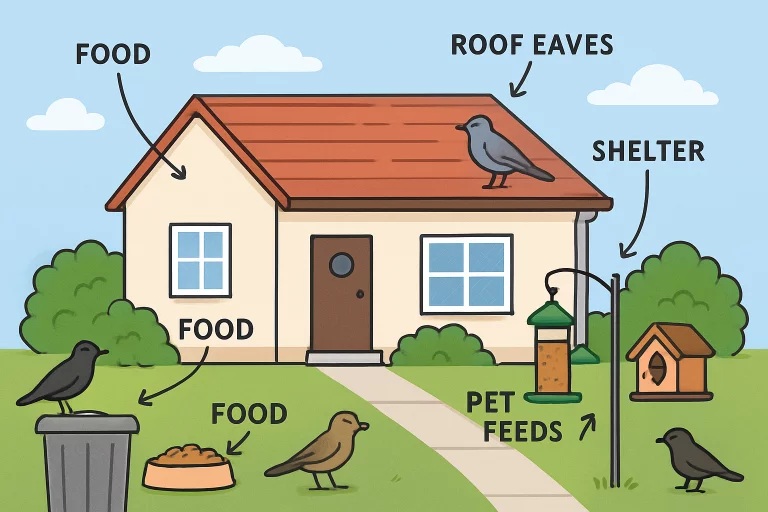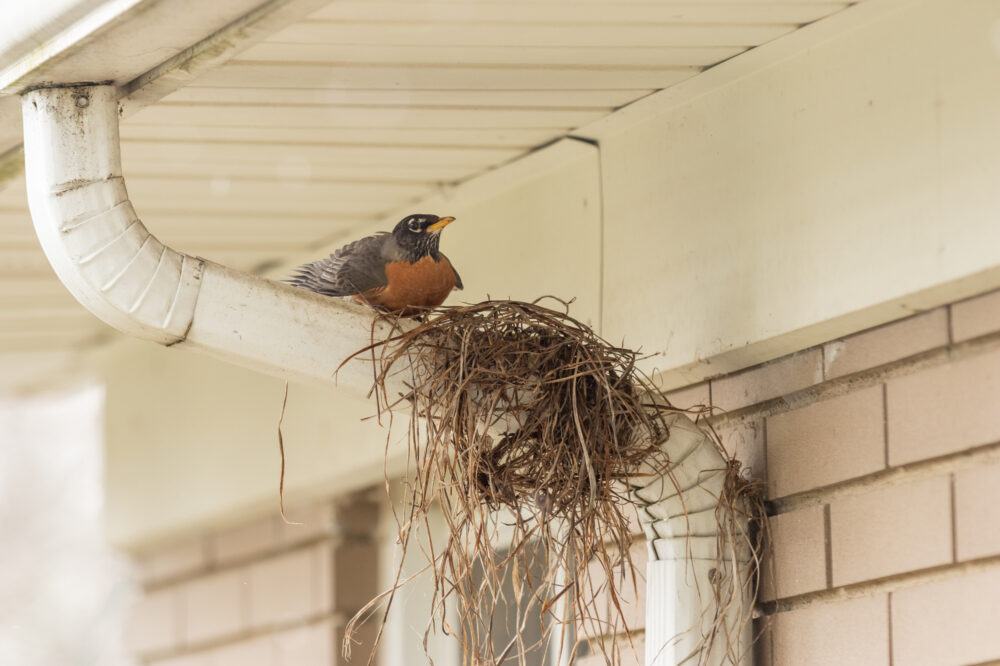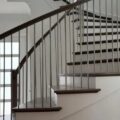Key Takeaways:
- Humane bird control strategies balance the need for property protection with a deep respect for local wildlife.
- Combining physical, visual, auditory deterrents, and habitat modifications forms the foundation of a successful, non-harmful approach.
- Strict adherence to legal and ethical standards is paramount to avoid penalties and ensure animal welfare.
- Seeking professional assistance and maintaining regular property checks increases the likelihood of long-term, humane bird control.
Introduction
Maintaining harmony between homeowners’ needs and wildlife conservation is at the heart of effective bird management, especially given the growing overlap between human development and natural habitats. Taking a humane approach ensures your property remains protected while fostering respect for birds’ ecological roles as pollinators, pest controllers, and vital links in the food web. Rather than resorting to drastic, harmful measures, choosing compassionate and science-backed strategies—such as those provided by professional bird removal services—promises lasting protection for your home and a conscientious approach toward animal welfare. When bird infestations become complicated or overwhelming, relying on experts ensures compliance with wildlife laws and the humane treatment of our avian neighbors.
It is essential to start with a clear understanding of why birds are attracted to residential areas to resolve the challenges posed by problematic bird activity. Only then can you adopt a suite of humane deterrents and alter your surroundings to create a persistent, bird-unfriendly environment. Exploring these methods, as detailed throughout this article, will equip you to prevent unwanted visitors effectively and ethically, ensuring that you respect both the environment and the well-being of the birds themselves.
Understanding Bird Behavior
The cornerstone of a humane bird management strategy lies in understanding the habits and motivations that drive birds to settle around homes and yards. Birds are highly adaptive, gravitating to any place offering easy access to essential resources. This means overflowing bird feeders, uncovered trash bins, dog food left outside, or thick shrubs can all become magnets for birds searching for food, water, or shelter. When you understand the specific triggers that attract birds, your efforts to manage them become far more targeted and effective, reducing the need for repeated interventions.
Understanding the bird species that frequent your property is crucial in determining the most appropriate action. Different birds have distinct nesting habits—pigeons typically look for flat, sheltered areas to settle, starlings are known to squeeze into narrow gaps, and sparrows often choose dense shrubbery or quiet corners in sheds and garages. Observing these visitation and nesting patterns enables proper identification, which is essential for applying the most effective and legally compliant deterrent or removal methods. This same principle also applies to other wildlife concerns, such as bat removal, where knowing the species and their entry points is key to safe and humane exclusion. The more insight you gain into these animals’ routines and behaviors, the more precisely you can tailor your prevention strategies, ensuring they are both successful and respectful of local wildlife regulations.

Physical Deterrents
Physical deterrents are indispensable for homeowners who wish to stop birds from nesting or roosting without causing them harm. By actively blocking access to favored spots, you send a clear message that your property is unavailable for colonization. The most reliable physical solutions include:
- Bird Spikes: Discreet and effective, bird spikes prevent large birds from perching or nesting on ledges, sills, light fixtures, signage, and rooftops. Their non-injurious design encourages birds to seek alternative, safer localities without trapping or injuring them.
- Bird Netting: Using fine, barely noticeable netting can seal off entire sections like eaves, attics, and gardens, making these spots completely off-limits for birds. Properly installed, bird netting offers robust long-term protection without detracting from your home’s appearance.
- Chimney Caps and Vent Covers: These simple but sturdy barriers prevent birds from entering hazardous and hard-to-reach dwellings, such as chimneys, dryer vents, and attic fans—sites which can otherwise lead to dangerous and costly blockages for homeowners.
All physical deterrents should be routinely inspected to ensure they remain secure, undamaged, and free of trapped wildlife. This ongoing diligence is crucial for both maintaining effectiveness and upholding humane standards.
Visual & Auditory Deterrents
Augmenting physical measures with visual and auditory deterrents can dramatically increase your success, particularly when used in tandem to create a hostile environment for unwanted birds. Proven options include:
- Reflective Objects: Items such as reflective tape, aluminum foil strips, pinwheels, and old CDs hung from branches, patios, or fences catch the sunlight and create erratic flashes that confuse and scare birds away.
- Predator Decoys: Lifelike models of owls, hawks, or snakes, especially those with gleaming reflective eyes, play on birds’ natural instincts to avoid danger. Moving these decoys periodically helps maintain their effectiveness as birds quickly learn to ignore stationary threats.
- Sound Devices: Electronic gadgets that emit unpredictable predator calls, distress sounds, or ultrasonic frequencies can startle and deter birds. Since birds may become accustomed to these noises with time, varying their placement and changing the sounds occasionally is key to sustained results.
For best results, use an integrated approach that involves repositioning decoys, occasionally introducing new types, and combining sounds and lights to maximize the sense of unpredictability. Layered deterrence amplifies the overall impact and dissuades even the most persistent birds.
Habitat Modification
Perhaps the most sustainable and humane way to prevent bird problems is by making your property less attractive through direct habitat modification. This strategy aims for long-term change by addressing the environmental factors that invite birds in the first place:
- Remove Food Sources: It’s vital to secure garbage in sturdy, closed bins, bring pet food indoors after mealtimes, minimize the use of bird feeders, and promptly remove fallen fruit and stray crumbs. Vigilant housekeeping is your first line of defense against large flocks.
- Eliminate Water Sources: Address leaks, standing puddles, or uncovered water features on your property. Regularly emptying planters, buckets, and other vessels prevents birds from lingering for a drink or bath.
- Trim Vegetation: Cut trees, sprawling shrubs, and high grass around buildings. Reducing dense cover—especially near entrances, windows, or roofs—removes the enticing shelter many birds crave during nesting, thus making your home far less desirable.
These preventative actions not only discourage birds but also help reduce the chances of related pest infestations, contributing to a healthier and more manageable outdoor environment.
Legal & Ethical Considerations
Responsible bird control centers on strict observance of federal, state, and local laws governing the treatment of birds. Many of these laws, like the Migratory Bird Treaty Act, extend protection to even common species. It is illegal, for example, to deliberately harm birds, disturb active nests, or use lethal removal methods without a permit. Disregarding these regulations can result in hefty fines and unintended harm to protected species.
Should you come across an active nest, especially one containing eggs or hatchlings, or be uncertain about what actions are permissible, always consult with wildlife agencies or ethical animal control professionals before proceeding. This commitment not only shields you from legal risks but also reflects a compassionate approach to coexistence with local wildlife.
Professional Assistance
When bird-related problems persist or involve protected or aggressive species, turning to trained professionals is the safest course. Wildlife specialists possess the training, insight, and access to advanced tools necessary for complex or persistent problems, crafting targeted solutions that are both effective and compliant with the law. They routinely design programs that address birds’ immediate presence and recommend changes to prevent recurring issues.
Suppose you live in large urban areas or face infestations that exceed do-it-yourself solutions. In that case, professionals bring years of experience and regulatory knowledge to each case. Collaborating with such experts amplifies your chances for a humane, efficient outcome.
Regular Maintenance & Monitoring
Consistent vigilance is vital to ensuring the lasting success of humane bird control efforts. This means periodically checking all physical barriers, repositioning visual and auditory devices as birds get used to routine patterns, and reapplying deterrents following significant weather events or property changes. Regularly review your surroundings for new food or shelter sources and undertake seasonal evaluations to address emerging vulnerabilities as birds’ behavior shifts throughout the year.
Integrating these practices and staying proactive creates a dynamic, robust defense that consistently protects your home. Employing multiple humane strategies and committing to regular monitoring prevents bird-related damage and reinforces your role as a responsible steward of the local ecosystem..






Leave a Reply